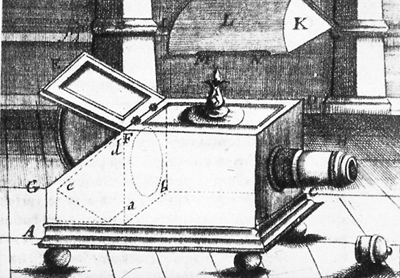Sequence viewing > Index - Cameras - lenses - optics - Resource - ©
Lloyd Godman
Film - Digital
What
is a Camera ? - History of the camera obscura
From
the 13th Century Roger Bacon, an English monk and philosopher,
and his contemporaries used the devise to observe eclipse of the sun,
which could not be done directly without damaging the eyes.
The
design was significantly improved with addition of a glass
lens to form a brighter and sharper image during the mid-1500s.
Artists began using small portable versions of what became known as
the camera obscura to aid them in drawing realistic representations
of portraits, landscapes and architectural subjects. A thin
piece of transparent paper was laid on the glass where the image formed
and the artist traced the outline of the scene they wanted onto the
paper. The camera obscura was directly responsible for the fascination
and understanding of geometric perspective developed during the Renaissance
and the rebirth of Classical culture.

So the
camera can be seen simply as a light tight box, with a single small
opening that lets the light onto the film.
Once
an effective photographic process was invented around 1839 the tracing
paper was replaced with a sensitized material where the image could
be imprinted directly onto the paper. From here the camera and the
photographic process as we know it evolved.
Want to learn more? - do a workshop or one on one with Lloyd Godman
|